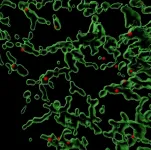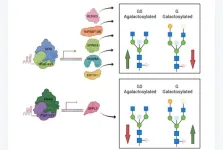(Press-News.org) A groundbreaking study published in the American Journal of Respiratory and Critical Care Medicine provides new insights into the treatment of obstructive sleep apnea (OSA) and its associated health impacts.
Researchers at the University of Missouri School of Medicine and the Marshall University Joan C. Edwards School of Medicine led by David Gozal, M.D., M.B.A., Ph.D. (Hon), vice president of health affairs at Marshall University and dean of the Joan C. Edwards School of Medicine, explored innovative therapeutic strategies that could greatly advance the understanding and management of OSA-related morbidities. Obstructive sleep apnea is a widespread condition affecting nearly one billion people around the world. It is linked to accelerated biological aging and various end-organ health issues, such as cardiovascular, cognitive and metabolic morbidities. While current treatments like continuous positive airway pressure (CPAP) have demonstrated limited success in reversing such outcomes, this recent research delves into adjunct therapies, particularly the use of senolytics, to alleviate the burden of OSA.
The study assessed whether targeting senescence, a treatment that targets aging cells, coupled with a simulated approach that imitates good adherence to the most common treatment for sleep apnea (CPAP) could improve physiological outcomes in mice exposed to chronic intermittent hypoxia (IH), a hallmark feature of OSA. The study found that combining partial normoxic recovery with the senolytic Navitoclax (NAV) significantly reduced sleepiness during the dark phase, the usual sleeping time for rodents. The combined therapy also showed notable improvements in cognitive function. Such findings were not apparent when only “CPAP” was administered.
“Our findings suggest that the reversibility of end-organ morbidities induced by OSA goes beyond normalizing oxygenation patterns,” said Gozal, corresponding author on the study. “Targeting accelerated senescence appears to be a promising avenue for improving treatment outcomes in individuals with OSA.”
“It is quite evident in our preclinical model of OSA that recovering normal oxygenation patterns seen in traditional treatments, namely continuous positive airway pressure, is ineffective in preventing or mitigating multiple end-organ dysfunctions” said Mohammad Badran, Ph.D., assistant professor at the University of Missouri School of Medicine. “Adjuvant therapies, in this case senolytics, have the potential of becoming valuable and effective treatments targeting OSA-induced morbidities.”
In addition, the therapy demonstrated positive effects on coronary artery function, glucose and lipid metabolism and reduced intestinal permeability. The combination of simulated adherent CPAP treatment and NAV effectively reduced senescence in multiple organs, indicating a potential reversal of OSA-induced cellular aging processes.
This research could open new doors in understanding the deleterious processes involved in OSA-associated morbidities and formulate novel approaches aimed at reversing the multifaceted impact of OSA on health. Development of safe senolytics specifically focused on OSA along with clinical studies are warranted to validate these findings in human subjects and explore potential applications in the field of sleep medicine.
In addition to Gozal and Badran, co-authors on the study from the University of Missouri include Clementine Puech, Ph.D., post-doctoral fellow; Abdelnaby Khalyfa, Ph.D., associate professor; Rene Cortese, Ph.D., assistant professor in the Department of Child Health and the Department of Obstetrics, Gynecology and Women’s Health; Kylie Cataldo, research specialist; and Zhuanhong Qiao, senior research consultant.
To view the article in its entirety, visit “Senolytic-facilitated Reversal of End-Organ Dysfunction in a Murine Model of Obstructive Sleep Apnea,” please visit https://doi.org/10.1164/rccm.202306-1101oc.
END
Research reveals promising approach to enhance treatment for sleep apnea-related issues
2024-01-03
ELSE PRESS RELEASES FROM THIS DATE:
Seismic and infrasonic signals used to characterize Nord Stream pipeline events
2024-01-03
Seismic events that coincided with sudden drops in pressure within the Nord Stream 1 and 2 natural gas pipelines in September 2022 alerted the world to the rupture of pipelines in the western Baltic Sea. The suspected act of sabotage, which reportedly used explosive charges to rupture the pipelines, is still under investigation by multiple countries.
A new study published in The Seismic Record provides further evidence that the Nord Stream seismic signals came from a complex source. The signals lasted longer than would be expected from a single explosive source, the ...
Surprise! – How the brain learns to deal with the unexpected
2024-01-03
For children, the world is full of surprises. Adults, on the other hand, are much more difficult to surprise. And there are complex processes behind this apparently straightforward state of affairs. Researchers at the University of Basel have been using mice to decode how reactions to the unexpected develop in the growing brain.
Babies love playing peekaboo, continuing to react even on the tenth sudden appearance of their partner in the game. Recognizing the unexpected is an important cognitive ability. After all, new can also mean dangerous.
The exact way in which surprises are processed in the brain changes as we grow, however: unusual ...
Genetic variants underlying male bisexual behavior, risk-taking linked to more children, study shows
2024-01-03
ANN ARBOR—Because same-sex sexual behavior does not result in offspring, evolutionary biologists have long wondered how the genes associated with this behavior have persisted in the human genome, and whether they will remain in the future.
A new University of Michigan-led study, scheduled for publication Jan. 3 in the journal Science Advances, suggests that part of the explanation—specifically for male bisexuals—has to do with risk-taking behavior.
The U-M researchers analyzed data from more than 450,000 participants of European ancestry in the United Kingdom's Biobank database of genetic and health information. Participants responded to a questionnaire ...
Shining a light on the hidden damage of mild brain injuries
2024-01-03
Researchers have created a new brain imaging method that allows mild traumatic brain injuries (mTBIs) to be diagnosed, even when existing imaging techniques like magnetic resonance imaging (MRI) don’t show any structural abnormalities. The technique involves loading gadolinium, a standard MRI contrast agent, into hydrogel-based micropatches that are attached to immune cells called macrophages. mTBIs cause inflammation in the brain, which produces signals that attract macrophages to migrate there. Coupling the gadolinium contrast agent to these cells enables MRI to reveal ...
Weill Cornell Medicine receives grant for blood test to diagnose breast cancer
2024-01-03
Weill Cornell Medicine researchers received a $2.4 million grant from the U.S. Department of Defense Breast Cancer Research Program to validate a new blood test for the early detection of breast cancer.
Researchers are evaluating Syantra DX Breast Cancer (Syantra Inc.), an experimental diagnostic test that detects specific biomarkers in blood associated with breast cancer. The test uses an artificial intelligence algorithm to determine whether a patient is positive for cancer as soon as detectable by mammogram or possibly earlier, and before symptoms arise.
“This new liquid biopsy, ...
Using the body’s own cells to treat traumatic brain injury
2024-01-03
Scientists have created a new treatment for traumatic brain injury (TBI) that shrank brain lesions by 56% and significantly reduced local inflammation levels in pigs. The new approach leverages macrophages, a type of white blood cell that can dial inflammation up or down in the body in response to infection and injury. The team created disc-shaped microparticles called “backpacks” containing anti-inflammatory molecules, then attached them directly to the macrophages. These molecules kept the cells in an anti-inflammatory state ...
UW–Madison scientists reveal the inner workings of an essential protein trafficking complex
2024-01-03
MADISON – Like mail carriers who manage to deliver their parcels through snow, rain, heat and gloom, a critical group of mammalian proteins helps cells function properly even under less-than-ideal conditions.
Using state-of-the-art cell imaging and genome editing technology, University of Wisconsin–Madison scientists have begun to unravel how this collection of proteins performs its essential service. The discovery could eventually help researchers better understand and develop new treatments for diseases like cancer, diabetes and those that cause immune dysfunction.
Led by Anjon Audhya, a professor in the Department of Biomolecular Chemistry, the research team sought ...
Mapping of the gene network that regulates glycan clock of ageing
2024-01-03
“[...] we were able to confirm the functional role of three genes (MANBA, TNFRSF13B and EEF1A1) in the IgG galactosylation pathway [...]”
BUFFALO, NY- January 3, 2024 – A new research paper was published in Aging (listed by MEDLINE/PubMed as "Aging (Albany NY)" and "Aging-US" by Web of Science) Volume 15, Issue 24, entitled, “Mapping of the gene network that regulates glycan clock of ageing.”
Glycans are an essential structural component of immunoglobulin G (IgG) that modulate its structure and function. However, regulatory mechanisms behind this complex posttranslational ...
Computational method discovers hundreds of new ceramics for extreme environments
2024-01-03
DURHAM, N.C. – If you have a deep-seated, nagging worry over dropping your phone in molten lava, you’re in luck.
A research team led by materials scientists at Duke University has developed a method for rapidly discovering a new class of materials with heat and electronic tolerances so rugged that they that could enable devices to function at lava-like temperatures above several thousands of degrees Fahrenheit.
Harder than steel and stable in chemically corrosive environments, these materials ...
Community cancer care linked with poorer outcomes for patients with a common head and neck cancer
2024-01-03
FOR IMMEDIATE RELEASE
Care for patients with human papillomavirus (HPV)-related squamous cell cancers of the oropharynx (an area in back of the throat) is shifting toward community cancer centers, but patients treated in this setting may be less likely to survive, according to new research by investigators from the Johns Hopkins Kimmel Cancer Center and its Head and Neck Cancer Center.
The study, published Jan. 3 in the Journal of the National Cancer Institute, raises concerns about the quality of care that patients with this type of head and neck cancer receive outside of academic medical centers. Patients treated ...


